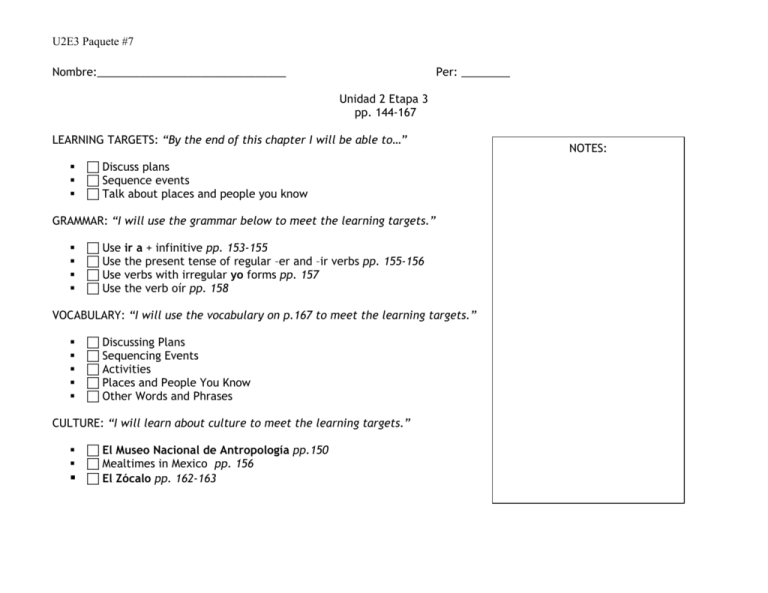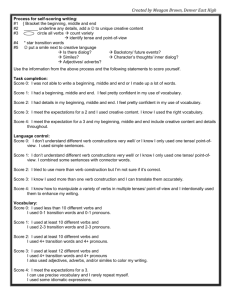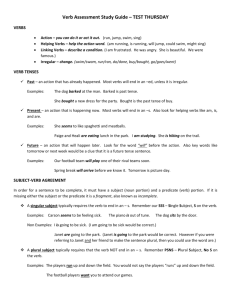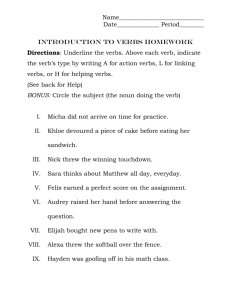Nombre
advertisement

U2E3 Paquete #7 Nombre:_______________________________ Per: ________ Unidad 2 Etapa 3 pp. 144-167 LEARNING TARGETS: “By the end of this chapter I will be able to…” Discuss plans Sequence events Talk about places and people you know GRAMMAR: “I will use the grammar below to meet the learning targets.” Use Use Use Use ir a + infinitive pp. 153-155 the present tense of regular –er and –ir verbs pp. 155-156 verbs with irregular yo forms pp. 157 the verb oír pp. 158 VOCABULARY: “I will use the vocabulary on p.167 to meet the learning targets.” Discussing Plans Sequencing Events Activities Places and People You Know Other Words and Phrases CULTURE: “I will learn about culture to meet the learning targets.” El Museo Nacional de Antropología pp.150 Mealtimes in Mexico pp. 156 El Zócalo pp. 162-163 NOTES: U2E3 Paquete #7 TRACKING MY PROGRESS – U2E3 La fecha Assessment Nota (Vocabulary, Grammar, Project, etc…) (Points, Percent, Letter Grade) PARENT/GUARDIAN COMMENTS & SIGNATURE: (Parent/Guardian I am required to discuss the learning targets of this chapter and my assessment (vocabulary and grammar) scores with you. After our discussion would you please comment on my progress and date and sign your name. Gracias.) U2E3 Paquete #7 I. SAYING WHAT YOU ARE GOING TO DO…ir + a + infinitive p. 153 ¿RECUERDAS? You’ve already learned the conjugations of the verb ir and how to describe where you are going. ir + a + place Ejemplo: Yo voy a la clase de español. When you talk about things you are planning to do in the future, you say what you are going to do. To talk about activities you are going to do, use the formula: __________ + ___________ + ____________ Ejemplo: Tú vas a bailar. You are going to dance. Él va a estudiar. Nosotros vamos a comer. ir – to go ¿Qué vas a hacer después de la escuela? What are you going to do after school? U2E3 Paquete #7 Saying Where You Are Going VS. Saying What You Are Going To Do ir + a + place = saying where you are going Yo voy a la biblioteca. Ella va al auditorio. ir + a + infinitive = saying what you are going to do Yo voy a estudiar español. Él va a hacer ejercicio. In the following sentences, are you trying to say: where you are going? what you are going to do? 1. Voy a la oficina. 2. Voy a usar la computadora. 3. Voy a hacer la tarea. 4. Voy a casa. 5. Voy al gimnasio. 6. Voy a pasar un rato con mis amigos. U2E3 Paquete #7 II. PRESENT TENSE OF REGULAR –ER AND –IR VERBS p. 155 ¿RECUERDAS? p. 109 Remember how to conjugate present tense –ar verbs? -ar verb endings Regular verbs that end in __________ or __________ work similarly. Regular –er verbs have the same endings as -ir verbs except in the __________ and __________ forms. -er verb endings -ir verb endings NOTICE: The letter change matches the verb ending in the nosotros and vosotros forms: -er verbs = emos, éis -ir verbs = imos, ís PRÁCTICA: Conjugate the following verbs. Include the English translations comer – to eat yo como I eat. escribir – to write yo escribo I write. U2E3 Paquete #7 III. REGULAR PRESENT TENSE VERBS WITH IRREGULAR YO FORMS p. 157 These are verbs that have regular present tense forms except for an irregular __________ form. conocer – to know, to be familiar with (a person or a place) hacer – to do, to make La “a” personal: Whenever a __________ is the object of a verb, the personal a must be used after the __________ except when using the verb tener. Ejemplo: Yo conozco a Carlos. Yo voy a cuidar a mi hermano. I know Carlos. I am going to take care of my brother. La “a” personal may also be used when talking about animals that are pets, but it is not required. Ejemplo: Yo voy a cuidar (a) mi gato. I am going to take care of my cat. U2E3 Paquete #7 IV. USING THE VERB OÍR p. 158 Like __________ and __________, the verb __________ (to hear) has an irregular yo form in the present tense. o Some of its forms also require a spelling change where the ____ becomes a ____. o Note that the __________ and __________ forms have accents. oír – to hear I hear we hear you hear you all hear he/she hears you (fm.) hear they hear you all hear You may hear the expression __________ used throughout the dialog. It is used to get someone’s attention, the way Hey! is used in English.








